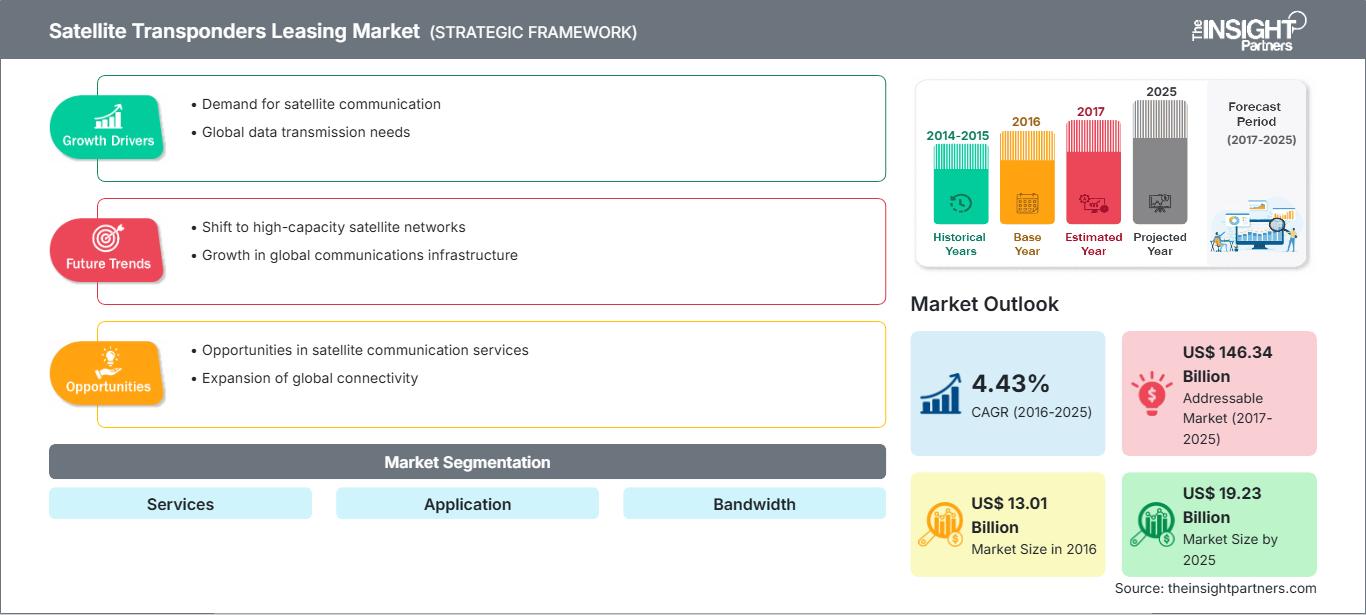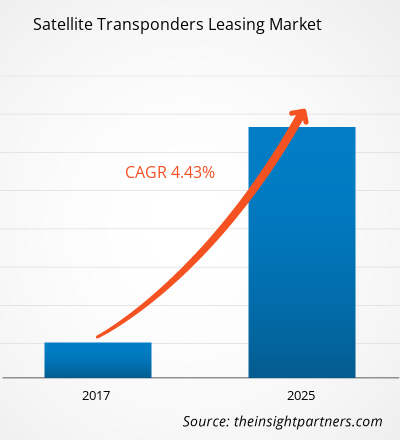Espansione delle applicazioni in banda Ku per generare nuove opportunità per il mercato del leasing di transponder satellitari per comunicazioni
La trasmissione in diretta e la distribuzione video sono alcune delle principali applicazioni dei satelliti in banda Ku, utilizzati anche per diversi servizi dati, tra cui servizi VSAT, connettività a banda larga, backhaul mobile, servizi aeronautici e marittimi. In questo mondo altamente connesso, tutte queste applicazioni sono considerate fondamentali per il funzionamento di un'azienda. Infatti, la banda Ku è lo spettro principale utilizzato dalle reti di mobilità per fornire connettività a banda larga nelle aree non raggiungibili dalle reti terrestri, ovvero oltreoceano e nella troposfera. La banda Ku cattura circa il 40% del mercato in termini di larghezza di banda. Si prevede che la domanda di transponder in banda Ku aumenterà grazie alla crescente popolarità della TV satellitare, in particolare nelle economie in via di sviluppo, ulteriormente supportata dall'HD (Alta Definizione) e dalla domanda di altre applicazioni simili in termini di larghezza di banda. Si prevede che l'evoluzione dei canali 3D, che consumano una maggiore larghezza di banda e richiedono il 50% di capacità in più, darà un nuovo impulso al mercato dei transponder satellitari in banda Ku. Seguono i transponder in banda C, che attualmente detengono la quota di mercato maggiore, ma si prevede un calo costante durante il periodo di previsione, perdendo la loro importanza a favore della banda Ku e di altre bande simili. Pertanto, si prevede che questa espansione delle applicazioni in banda Ku genererà nuove opportunità per il mercato del leasing dei transponder satellitari.
Il leasing di transponder come servizio dominerà il segmento di servizi globali del mercato del leasing dei transponder satellitari
Negli ultimi uno o due anni, il mercato globale dei transponder satellitari ha registrato un aumento di circa il 4,3-4,5% nella domanda di transponder in leasing. Si prevede che questa tendenza aumenterà ulteriormente a causa dell'aumento vertiginoso dei costi dei transponder in tutto il mondo. Considerando il mercato del leasing dei transponder satellitari, l'Europa si distingue come la regione più costosa, seguita da Australia e Nuova Zelanda. Considerando che l'Asia meridionale offre i tassi di leasing più bassi, l'Asia-Pacifico è considerata la regione più promettente per il mercato del leasing di transponder satellitari nei prossimi anni. Recentemente, la società satellitare coreana KT SAT ha firmato un contratto di leasing di transponder con un operatore televisivo satellitare mongolo; il fornitore di servizi KT SAT ha affiliato il leasing di quattro transponder, che consentiranno di offrire servizi DTH alle aziende mongole che verranno avviate nel prossimo anno. Considerando che si prevede che la società televisiva DDISH trarrà vantaggio dai servizi di KT SAT nel 2017. Il leasing di transponder satellitari per comunicazioni dipende fortemente dall'adozione della trasmissione video HD e dalla diffusione delle applicazioni HDR (High Dynamic Range). Tuttavia, si prevede che i servizi di leasing guideranno il mercato del leasing di transponder satellitari con una quota di mercato relativamente elevata, soggetta a fluttuazioni a seconda della revisione del costo di acquisto dei transponder satellitari e del costo totale di lancio di un satellite e della sua manutenzione.
Personalizza questo rapporto in base alle tue esigenze
Potrai personalizzare gratuitamente qualsiasi rapporto, comprese parti di questo rapporto, o analisi a livello di paese, pacchetto dati Excel, oltre a usufruire di grandi offerte e sconti per start-up e università
Mercato del leasing di transponder satellitari: Approfondimenti strategici

-
Ottieni le principali tendenze chiave del mercato di questo rapporto.Questo campione GRATUITO includerà l'analisi dei dati, che vanno dalle tendenze di mercato alle stime e alle previsioni.
L'iniziativa di mercato è stata osservata come la strategia più adottata nel mercato globale del leasing di transponder satellitari. Di seguito sono elencate alcune delle recenti strategie di alcuni degli operatori del mercato del leasing di transponder satellitari:
- 2016: GlobalSat ottiene la licenza per Inmarsat Ka e servizi in banda L in tutto il Messico
- 2016: MVS USA aggiorna la rete di comunicazione satellitare con un occhio alla sicurezza informatica
- 2016: O3b e Ozonio portano la banda larga in un'altra città amazzonica in Brasile
- 2016: Le scuole africane trarranno vantaggio dal nuovo accordo Gazprom-Gilat
- 2016: L'Indonesia realizza l'accesso alla banda larga in aree sottoservite con Newtec
Approfondimenti regionali sul mercato del leasing di transponder satellitari
Le tendenze regionali e i fattori che influenzano il mercato del leasing di transponder satellitari durante il periodo di previsione sono stati ampiamente spiegati dagli analisti di The Insight Partners. Questa sezione illustra anche i segmenti e la geografia del mercato del leasing di transponder satellitari in Nord America, Europa, Asia-Pacifico, Medio Oriente e Africa, America meridionale e centrale.
Ambito del rapporto sul mercato del leasing di transponder satellitari
| Attributo del rapporto | Dettagli |
|---|---|
| Dimensioni del mercato in 2016 | US$ 13.01 Billion |
| Dimensioni del mercato per 2025 | US$ 19.23 Billion |
| CAGR globale (2016 - 2025) | 4.43% |
| Dati storici | 2014-2015 |
| Periodo di previsione | 2017-2025 |
| Segmenti coperti | By ServiziBy ApplicazioneBy Larghezza di banda |
| Regioni e paesi coperti |
Nord America
|
| Leader di mercato e profili aziendali chiave |
|
Densità degli operatori del mercato del leasing di transponder satellitari: comprendere il suo impatto sulle dinamiche aziendali
Il mercato del leasing di transponder satellitari è in rapida crescita, trainato dalla crescente domanda degli utenti finali, dovuta a fattori quali l'evoluzione delle preferenze dei consumatori, i progressi tecnologici e una maggiore consapevolezza dei vantaggi del prodotto. Con l'aumento della domanda, le aziende stanno ampliando la propria offerta, innovando per soddisfare le esigenze dei consumatori e sfruttando le tendenze emergenti, alimentando ulteriormente la crescita del mercato.

- Ottieni il Mercato del leasing di transponder satellitari Panoramica dei principali attori chiave
- Protetto
- Non protetto
- Preempibile
Per applicazione
- Governo e militare
- Telecomunicazioni
- Commerciale
- Ricerca e Sviluppo
- Navigazione
- Telerilevamento
Per larghezza di banda
- Banda Ku
- Banda Ka
- Banda C
- Altri (S, L, X e K)
Per geografia
- Nord America
- Stati Uniti
- Canada
- Messico
- Europa
- Russia
- Francia
- Germania
- Regno Unito
- Lussemburgo
- Resto d'Europa
- Asia Pacifico (APAC)
- Cina
- India
- Giappone
- Resto dell'APAC
- Medio Oriente e Asia Africa (MEA)
- Arabia Saudita
- Sudafrica
- Israele
- Emirati Arabi Uniti
- Resto del MEA
- Sud America (SAM)
- Brasile
- Argentina
- Resto del SAM
Azienda Profili
- Intelsat
- SES
- Eutelsat
- Telesat
- SingTel Optus
- Sistemi satellitari MEASAT
- Asia Broadcast Satellite
- Arabsat
- ISRO
- China Satellite Communications Co.
- Analisi storica (2 anni), anno base, previsione (7 anni) con CAGR
- Analisi PEST e SWOT
- Valore/volume delle dimensioni del mercato - Globale, Regionale, Nazionale
- Industria e panorama competitivo
- Set di dati Excel
Report recenti
Testimonianze
Motivo dell'acquisto
- Processo decisionale informato
- Comprensione delle dinamiche di mercato
- Analisi competitiva
- Analisi dei clienti
- Previsioni di mercato
- Mitigazione del rischio
- Pianificazione strategica
- Giustificazione degli investimenti
- Identificazione dei mercati emergenti
- Miglioramento delle strategie di marketing
- Aumento dell'efficienza operativa
- Allineamento alle tendenze normative






















 Ottieni un campione gratuito per - Mercato del leasing di transponder satellitari
Ottieni un campione gratuito per - Mercato del leasing di transponder satellitari